A Short History of California Dragonfly (aka Odonata) Research
As recalled by Kathy Biggs (with help from Tim Manolis)
November 2006; updated October 2012
The first in-depth assessment of California's Odonata fauna was by Clarence Kennedy in 1914-1917. When I give programs, I often refer to him as the "Grandfather of California Dragonflies." I link to a few of his beautiful original drawings on my California Dragonflies Website. And his Notes on the Life History and Ecology of the Dragonflies (Odonata) of Central California and Nevada (1917, Proceedings of the U. S. National Museum, Vol. 52-No.2192), which summarizes most of this field work, remains well worth re-reading today, primarily for the wealth of information on identification, behavior, and life histories of the state's dragonflies. It is now available as a FREE google eBook.
In 1956 Smith and Pritchard's "Odonata" chapter in Aquatic Insects of California provided keys to dragonflies down to species, but included other western species not known to occur in California. This was Tim Manolis's and my original guide when we started looking at Odes. It includes drawings from Kennedy: See them at these links - http://southwestdragonflies.net/caphotos/SNAKESKN.JPG and http://southwestdragonflies.net/caphotos/SNAKSKN2.JPG and http://southwestdragonflies.net/caphotos/BRIMSTN.GIF and http://southwestdragonflies.net/caphotos/OLIVACE.GIF.
Then the first Odonata species list for California was compiled by Dennis Paulson
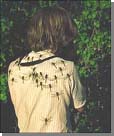 (1975 photo) and Rosser
Garrison and published in April 1977
in The Pan-Pacific Entomologist, A List and New Distributional Records of Pacific Coast Odonata: 53:147-160.
It showed 102 species. At the 2003 DSA meeting in California, CalOdes Members awarded Dennis and Rosser special DSA
Pins proclaiming them to be the "Fathers of California Dragonflies." Dennis is now retired and a member of our CalOdes
group and lives in Washington. Rosser is in Sacramento working for the California Department of Food and Agriculture.
Both Dennis and Rosser are world-renowned odonatologists and have been very generous with their time and expertise in
helping us learn about California's dragonflies.
(1975 photo) and Rosser
Garrison and published in April 1977
in The Pan-Pacific Entomologist, A List and New Distributional Records of Pacific Coast Odonata: 53:147-160.
It showed 102 species. At the 2003 DSA meeting in California, CalOdes Members awarded Dennis and Rosser special DSA
Pins proclaiming them to be the "Fathers of California Dragonflies." Dennis is now retired and a member of our CalOdes
group and lives in Washington. Rosser is in Sacramento working for the California Department of Food and Agriculture.
Both Dennis and Rosser are world-renowned odonatologists and have been very generous with their time and expertise in
helping us learn about California's dragonflies.
I started looking at dragonflies in 1996 when we built our backyard pond in Sebastopol and they appeared there. Soon I realized that I had more species than shown in Powell & Hogue's California Insects, so I started doing research. There were no identification books in the library or at the bookstores, so I started using the Internet (which was `new' back then!).
Also in 1996, Ron Lyons posted A list of California Dragonfly Species on a website, largely based on the list that Dennis and Rosser had compiled in 1977, thus making the list available to anyone on the Internet. Ron, now a CalOdes member even though he has moved to Oregon, has left an archival version of this website on the Internet.
I first found Ron's list and then another website with a list of species and links to photos. The second website was Blair Nikula's Dragonflies and Damselflies of Cape Cod.. I printed out Ron Lyon's list and then would print out a photo from Blair's website if I found a match, and then take this binder booklet into the field with me.
In August of 1996 the Dragonfly Society of the Americas (DSA) voted on Common Names for dragonflies. Dennis Paulson and Sid Dunkle were instrumental in forming this list of common names for North American Dragonflies.
Two new dragonfly resources became available later in 1996: Forrest Mitchell developed a technique for scanning
live dragonflies and put the scans of his Texas Dragonflies on his
 Digital Dragonflies Website.
Dennis Paulson published the list North American Odonata,
The Odonata of North America with Common (English) Names on the web at his
Dragonfly Biodiversity website. The updated website is still available. He next began putting
Scans of Washington's Odonata on the web. He also included a Field Key to
Washington Dragonflies which worked fairly well here in California. I was therefore able to expand the number of
photos of California species I could print out in my binder, and Dennis answered my emails and helped me with
identification skills. I've always considered Dennis to be my personal mentor.
Digital Dragonflies Website.
Dennis Paulson published the list North American Odonata,
The Odonata of North America with Common (English) Names on the web at his
Dragonfly Biodiversity website. The updated website is still available. He next began putting
Scans of Washington's Odonata on the web. He also included a Field Key to
Washington Dragonflies which worked fairly well here in California. I was therefore able to expand the number of
photos of California species I could print out in my binder, and Dennis answered my emails and helped me with
identification skills. I've always considered Dennis to be my personal mentor.
Ron Lyon's original California Dragonfly list was by scientific name only (it was posted before the Common Names were assigned). To thank Ron for all the help his website had been, I asked if I could add the newly assigned common names to it. He said yes and I did. Then I found that I wanted to add more to it, such as links and descriptions. So, with his permission I started a duplicate site in 1997: California Dragonflies and Damselflies aka California Odonata. I kept adding to the website as I discovered more information and made the decision to share as much of this information as I could so others wouldn't have to duplicate my efforts.
The website and my binder booklet kept growing. In late 1997 I received an email from another Californian who was interested in Dragonflies: Tim Manolis. He and I made a decision to go out the next year and see how many dragonfly species we could find. We did this starting in 1998. Tim read an article in the newspaper about a student at UCD who was studying dragonflies: Andy Rehn. We made an appointment to meet with him at the Bohart Insect Collection at UCD and we were given information on where Andy had found species and how to identify them.
We were now aware of how little information there was on the distribution of Dragonflies in California, and at Tim's and my request in April of 1998, Dennis Paulson sent a list with species by county to us on an Excel chart. There were 103 species on it with the Kiowa Dancer, Argia immunda, as the additional species added since his 1977 paper (actually collected in 1955!). I have kept an archival copy of this spreadsheet. It had only "zeros" and "ones" on it, where the "zeros" represented literature records, and "ones" represented specimens examined by Dennis in his own collection, and the collections of the California Academy of Sciences (CAS), the California Insect Survey collection (CIS), and the Los Angeles County Museum of Natural History (LACNNH).
Tim, Andy, and I quickly added 5 new numbers to the CA_OD_counties excel chart: 2 - UCD/Bohart Museum collection examined by A. Rehn &/or T. Manolis; 3 - Cal. State Univ., Chico by T. Manolis &/or A. Rehn; 4 - Cal. State Univ., Sacramento by T. Manolis &/or A. Rehn; 5 - CAS - CA Acad. of Sciences - Manolis, Biggs, Rehn; and our own research: 6 - collection of Tim Manolis; and 7 - collection of Kathy Biggs. Other folks soon began bringing their specimens and photo collections to us for review, including Rich Stallcup, Jeff Cole, Alvaro Jaramillo, Greg Kareofelas, Ron LeValley, David Wyatt, and others. In 1998 I started a sightings site to record our findings.
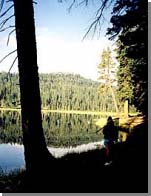 It was also in 1998 that Tim Manolis and Andy Rehn added three new species for
the state - Belted Whiteface, Leucorrhinia proxima; Canada Darner, Aeshna canadensis; and Autumn Meadowhawk,
Sympetrum vicinum -- the first two collected at Willow Lake in Tehama County, the latter species collected in 1980
(found in the Bohart Museum at UC Davis in a drawer of previously unidentified specimens) by Andy Rehn, and found again in
1998 at Willow Lake. State list at 106 species.
It was also in 1998 that Tim Manolis and Andy Rehn added three new species for
the state - Belted Whiteface, Leucorrhinia proxima; Canada Darner, Aeshna canadensis; and Autumn Meadowhawk,
Sympetrum vicinum -- the first two collected at Willow Lake in Tehama County, the latter species collected in 1980
(found in the Bohart Museum at UC Davis in a drawer of previously unidentified specimens) by Andy Rehn, and found again in
1998 at Willow Lake. State list at 106 species.
My girlfriends had found I was always either out chasing dragonflies or working on the website. They teased me that I should write a field guide. In July of 1999 I took the California dragonflies binder along with me on the Sonoma County Butterfly count. Needless to say, I counted butterflies and dragonflies. Also on this trip was Doug Vaughan. He asked if I could give/sell him a copy of this information. That gave me the nerve to tell him that, although I couldn't because these weren't images I had permission to distribute, I had started writing my own field guide. Doug's wife, Doris Kretschmer, was editor for the Natural History Guides series at University of California Press. A call from her took me to the UCPress offices to meet her. She said UCPress was interested in publishing a dragonfly guide and asked if anyone I knew or I would be interested in writing one. I knew what I wanted to write, a simple beginner's guide, and they were interested in more than that. So I told them about Tim Manolis. Tim was trying to learn as much as he could about dragonflies and to see as many dragonflies as possible that year, the first ever "Ode Big Year;" he ended up seeing 100 of the 103 species reported that year.
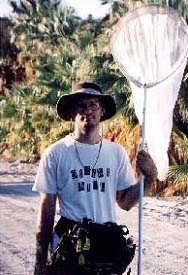 It was also in 1999 that Jeff Cole discovered that the specimens we had all
collected that spring at Dos Palmas (Kathy and Dave Biggs, Jeff Cole, Rosser and Jo Garrison and family, Tim and Annette
Manolis) were not Desert Forktails, Ischnura barberi, as we had presumed, but Rambur's forktails,
Ischnura ramburii!! The species, originally removed by Dennis and Rosser in 1977, was now added back to state list.
State list at 107 species.
It was also in 1999 that Jeff Cole discovered that the specimens we had all
collected that spring at Dos Palmas (Kathy and Dave Biggs, Jeff Cole, Rosser and Jo Garrison and family, Tim and Annette
Manolis) were not Desert Forktails, Ischnura barberi, as we had presumed, but Rambur's forktails,
Ischnura ramburii!! The species, originally removed by Dennis and Rosser in 1977, was now added back to state list.
State list at 107 species.
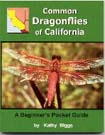 In May of 2000, my Common Dragonflies of California, A Beginner's Pocket Guide
was published by Azalea Creek Publishing (Dave and Kathy Biggs) and I began giving
programs about dragonflies. Later that year, Sid Dunkle's Dragonflies through Binoculars was published by
Oxford Press.
In May of 2000, my Common Dragonflies of California, A Beginner's Pocket Guide
was published by Azalea Creek Publishing (Dave and Kathy Biggs) and I began giving
programs about dragonflies. Later that year, Sid Dunkle's Dragonflies through Binoculars was published by
Oxford Press.
Also in 2000 we discovered that a specimen of the Riffle Darner, Oplonaeschna armata had been collected in 1964 in California. It was found in the Florida State Collection of Arthropods and was discovered as part of Nick Donnelly's research for the USA dot-map project. We were quite busy that year helping with that project by sharing our spreadsheet information with Nick and visa versa. Nick's maps became the basis of the information later published at Odonata Central. I published my Field Key to Adult California Dragonflies (Odonata) on the Internet. State list at 108 species.
In 2001 Doug Aguillard started turning in dragonfly sightings. I shared with him my hope of someday having a dragonfly discussion group. He then started the CalOdes Yahoo! Discussion group in early 2002 and by 2006 there were at least 95 numbers for contributors/collections accessed on the California Dragonfly Distribution Excel chart.
 In 2003, Tim Manolis' comprehensive
Dragonflies and Damselflies of California was
published by UCPress with Tim's own art. This year also found myself and Dave, Tim, and Andy Rehn acting as hosts for the
DSA's annual meeting. We led field trips to Bear Creek in
Colusa County, Guenoc Pond in Lake County, Pope Creek in Napa County, and Bidwell Park and Cherry Hill Campground (aka
Butterfly Valley) in Butte County. Post trips went into the Owens Valley. Although no new state records were made, 65
folks attended and Californians and California became better known in the dragonfly world.
In 2003, Tim Manolis' comprehensive
Dragonflies and Damselflies of California was
published by UCPress with Tim's own art. This year also found myself and Dave, Tim, and Andy Rehn acting as hosts for the
DSA's annual meeting. We led field trips to Bear Creek in
Colusa County, Guenoc Pond in Lake County, Pope Creek in Napa County, and Bidwell Park and Cherry Hill Campground (aka
Butterfly Valley) in Butte County. Post trips went into the Owens Valley. Although no new state records were made, 65
folks attended and Californians and California became better known in the dragonfly world.
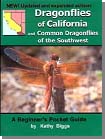 In 2004, I updated and expanded my Common Dragonflies of California
with the new title Common Dragonflies of the Southwest, A
Beginner's Pocket Guide.
In 2004, I updated and expanded my Common Dragonflies of California
with the new title Common Dragonflies of the Southwest, A
Beginner's Pocket Guide.
In 2005 the first annual CalOdes/DSA Dragonfly Blitz was held in Modoc County. No new state records were made, but the camaraderie was great fun, and so was finding an Ode in the snow!! Although they didn't join us on the Blitz, David Edwards and John Hall ended up having a "Big Year" seeing 104 of the 105 species reported that year!
In 2006 Azalea Creek Publishing published a dust jacket for the SW book making it more useful for Californians: Dragonflies of California and Common Dragonflies of the Southwest. The 2nd annual CalOdes/DSA Blitz was held in the extreme SE part of the state in Imperial County. We worked hard for it, but we did add one species to the Calif. state list: The Striped Saddlebags (Tramea calverti). David Blue had missed out on being able to go on the Blitz, but lived in Southern California, so he decided to try to find that Striped Saddlebags on his own. He missed it, BUT, he added the 111th species to the Calif. State record when that little pond where we'd seen the Citrine Forktail now held a Plateau Dragonlet!
In 2007 two new species were added to the state list as "one time occurances" - the Baja Bluet (this record has been challenged by one of our members however) and a really big surprise, the Turquoise-tipped Darner. These bring the Calif. state list to 113 species, where it stood until late 2012. Our CalOdes/DSA Dragonfly Blitz III was held in the beautiful Owens Valley, although no new state records were found, we had a wonderful time. This was also the year that Don Roberson had an "Ode Big Year" - seeing 106 of the 108 species reported that year.
In 2008, our CalOde Blitz IV was held in Modoc County AGAIN, because of wildfires in the Trinity County area we'd origianlly planned to go to. Many new county records were made, but we still weren't able to find our 'targeted species' - the Lance-tipped Darner.
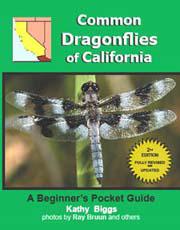 In 2009, Azalea Creek Publishing, aka Kathy & David Biggs, published a revised edition of their very successful Common Dragonflies
of California using primary the great photos taken by CalOdes member Ray Bruun. No Blitz was held this year
because of injuries to Dave Biggs. He fully recovered however :-)
In 2009, Azalea Creek Publishing, aka Kathy & David Biggs, published a revised edition of their very successful Common Dragonflies
of California using primary the great photos taken by CalOdes member Ray Bruun. No Blitz was held this year
because of injuries to Dave Biggs. He fully recovered however :-)
In 2010 the CalOdes/DSA group was finally able to hold their Blitz V in Trinity County.
The CalOdes/DSA Blitz 2011 was held in Needles, San Bernardino County. This was actually a tri-state Blitz taking in also the southwestern tip of Nevada and the northwestern tip of Arizona. See a PDF file about this blitz: Some Like it HOT!!. That winter Kathy Biggs wrote a "weightless" Dragonfly Guide: Dragonflies of California and the Greater Southwest - that is, she wrote an eGuide that could be used on Kindle, Nook &/or smart phone.
In 2012 the Blitz was held in undercensused Del Norte County in the far NW corner of Calif. As hoped for, we increased the county list, which went from just 29 species to 43. Odes in the Mist tells that story. AND, species #114 was found in early October: The Great Pondhawk, a species that had been searched for, but not found on the previous year's blitz!! That month also was the start-up month for a new FaceBook page, started by Sandra Hunt-von Arb: Western Odonata
Dragonfly watching has taken off as a new pursuit and the CalOdes group is not only sharing information with each other,
but they are actively pursuing distribution and flight season work. It's amazing that over 15,000 copies of the
Pocket Guide series have sold....more people than ever are into watching dragonflies. And the CalOdes group stands at 211 members.
The most recent history can be found recorded on the California Sightings pages at
California Dragonfly sightings by year site.
| 1977-1996 = 102 species
1997 = 103 species #103 Argia immunda, Kiowa Dancer - one found in Museum collection 1998 = 106 species #104 Leucorrhinia proxima, Belted Whiteface - bred a few years in Plumas Co. #105 Aeshna canadensis, Canada Darner - now known to breed in CA #106 Sympetrum vicinum, Autumn Meadowhawk - now known to breed in CA 1999= 107 species #107 Ischnura ramburii, Rambur's Forktail - now known to breed in CA 2000 = 108 species #108 Oplonaeschna armata, Riffle Darner - one found in Museum collection 2001-2003 = 108 species |
2004 = 109 species
#109 Pseudoleon superbus, Filigree Skimmer - photographed twice (same season, year & county) 2005 = 109 species 2006 = 111 species #110 Tramea calverti, Striped Saddlebags - ovipositing pairs found now for several years #111 Erythrodiplax basifusca, Plateau Dragonlet - photographed only twice (same month & year) 2007 = 113 species #112 Enallgama eiseni, Baja Bluet - photographed only once; some doubt about this record #113 Rhionaeschna psilus, Turquoise-tipped Darner - photographed only once 2008-2011 = 113 species 2012 = 114 species #114 Erythemis vesiculosa, Great Pondhawk - photographed only once |
Thank you for your interest! Cheers, Kathy Biggs